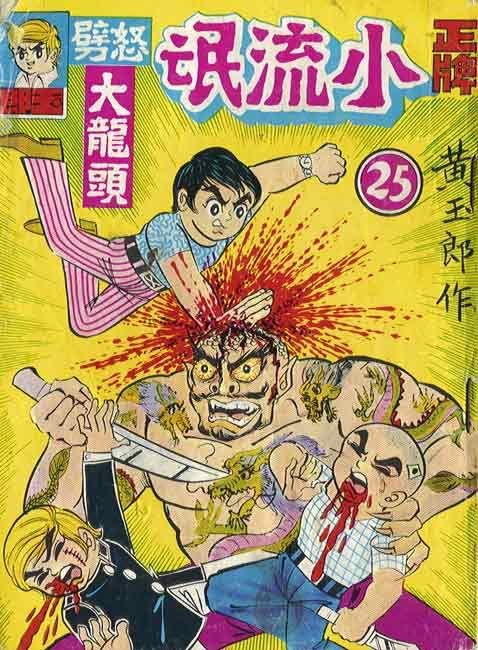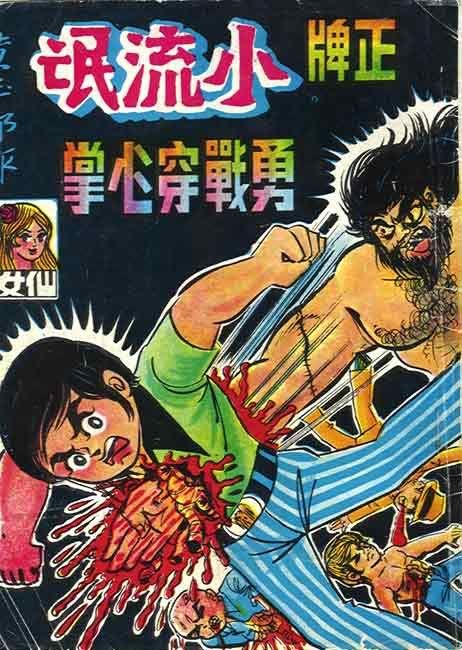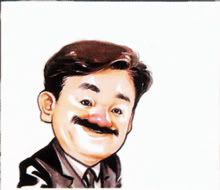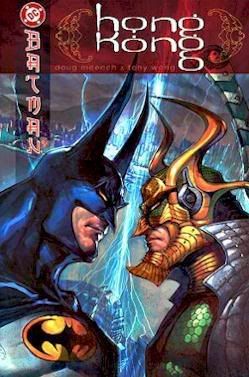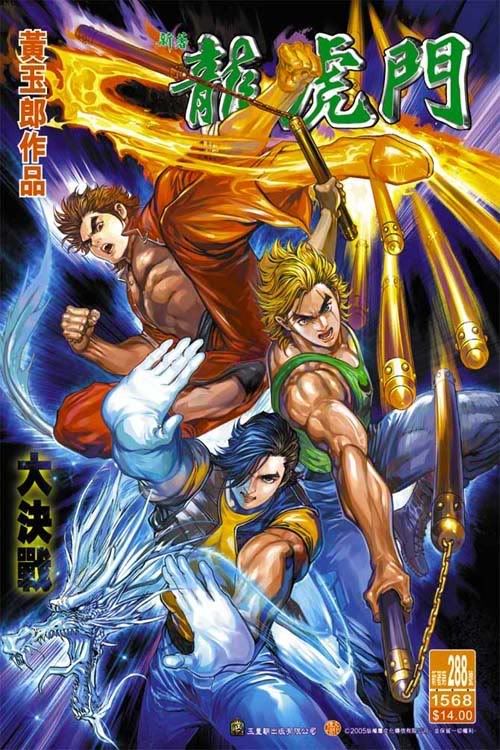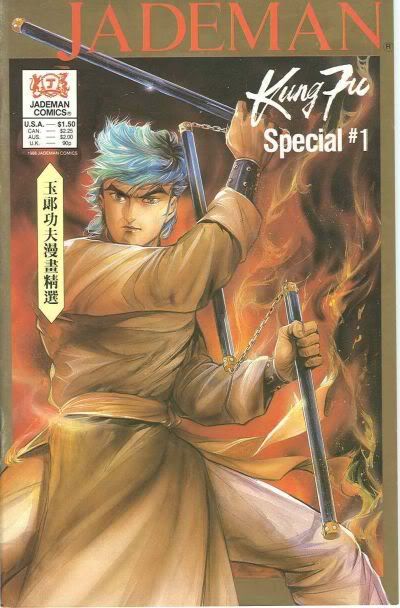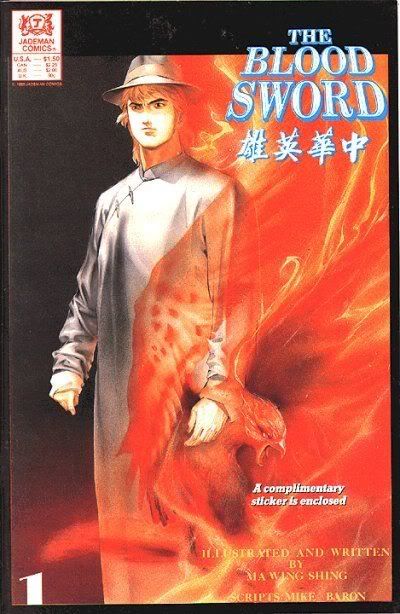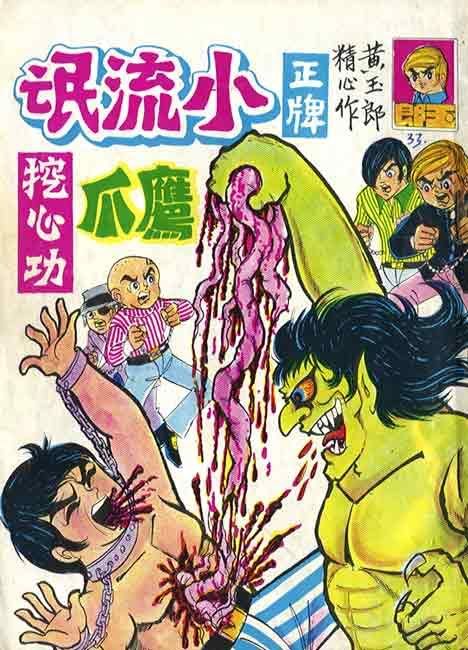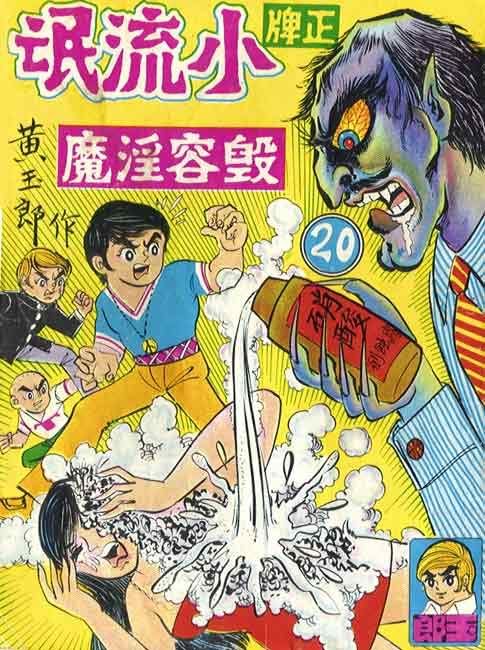My Life is Choked with Comics #14 - Jademan Comics
/![]() This is the story of how I met Jademan Wong.
This is the story of how I met Jademan Wong.
I.
In the beginning, there were the images. I couldn't tell you how I found them, but I did. They were volcanic eruptions of cartoon violence, the marching, oozing cover brand of old comic books. I didn't know a thing about them, but I never forgot them. That was how Jademan Wong -- writer, artist, funnybook publisher, studio head, newspaper magnate, national success, menace to youth, jailbird, fact, fiction, the king of Hong Kong comics -- got inside of me.
I doubt he's around anymore. Oh, he's alive. And working. Thriving, even. But that's not quite what I mean.
II.
When I think of Jademan Wong, I realize I'm contemplating an illusion, a personal image sold unsuccessfully to Americans in now-obscure comic books. But it sold to me. It didn't sell anything but itself, but it sold, long past its sell date. I wonder what he'd think of that.
The facts of Wong's life vary from account to account, and I regret having not read Wendy Siuyi Wong's 2002 book Hong Kong Comics: A History of Manhua, which is supposed to be the crucial book on the wider topic. Instead, I'll be taking much of my information from the publicity materials included with one of the comic books Jademan published in North America. Not everyone remembers, but Jademan Comics published over one hundred issues of Hong Kong manhua in English, for US consumption, from 1988 to 1993. When I tracked some down, they didn't look at all like the goopy, vivid things I'd seen before, so I didn't make the connection at first. But Jademan Wong was there.
In 1950, one Wong Yuk Long was born in China. His family moved to Hong Kong when he was seven, and there he began reading comics. Before long, he was writing and drawing the damned things - his first published work appeared when he was eleven. At the ripe old age of seventeen, he began publishing comics himself. His most successful company, Jademan, launched in 1971. Asian comics art expert Dr. John A. Lent notes that Wong "almost single-handedly fashioned contemporary Hong Kong comics," estimating that Jademan eventually gained 70-90% of the nation's comics trade.
Wong would eventually become known simply as Tony Wong. For his readers, he took the name "Jademan" Wong, literally becoming one with his publisher. It's how you give it a human face, you see.
Or maybe he just made that part up for his US history, and nobody in Hong Kong knew him as Jademan Wong at all - I am going off of promotion here.
But that's also how you can give it a human face, and it's Jademan Wong that I know.
III.
Jademan the company came to handle Wong's comics from top to bottom: production, printing, the works. The impact of Japanese manga on Hong Kong had already been huge, and Wong adopted many foreign attributes, including visual style and story content. And more.
In an interview with Giant Robot from a few years back, Wong cited Golgo 13 creator Takao Saito as an influence (albeit for his earlier James Bond adaptations), and I find that especially fitting - just as Saito established a vast studio of specialist employees to ultimately maintain a 44-page-per-week pace, Wong set himself up as the head of his own team, sketching out pages in pencil for a multitude of aides to complete, piece by piece, though in bleeding color and at American dimensions, weekly.
The kung fu comics fans out there among you have surely heard of the man's works, and are no doubt annoyed with my calling him "Jademan" so much. But I suspect most readers of this site have come across at least one comic that sports his art. By which I mean, his team's art. And one comic specifically.
Yep, same guy in charge.
As it turned out, the gory images that had so floored me were from the beginning of Wong's long-running series Oriental Heroes (or: Dragon Tiger Gate), then titled Little Rascals. Those really good covers only made up about the first fifty or so issues before things calmed down a little. Not that it kept Wong from running afoul of 1975 legislation prohibiting extreme violence in comics, although it was no big deal - Wong simply began his own newspaper to serialize his comics away from the law's grasp. That's just how he rolled. Ted May of It Lives and Injury Comics has more from that period at his site.
The series is still running today, although it looks slightly different.
I suspect Wong is not the type to let changes in popular taste pass him by. From my observation, his comics often look 'of their time,' regardless of exactly what time it is, certainly due to a constant influx of young employees to work the pens. I couldn't tell you how much Wong actually draws anymore, or how his comics even read, since I haven't gotten my hands on a very big sample, but I'm not really telling you about comics today anyway. I'm telling you about the vision comics can project of their creators.
Two comic books shaped my vision of Jademan Wong.
IV.
In 1988, Jademan Comics released its first offering in the US.
It previewed the company's four big upcoming series:
(the aforementioned)
(and)
(plus)
(with)
Mike Baron of Nexus and The Badger was recruited to provide English adaptations of the scripts, and apparently worked on all the comics in that initial special, although you can see that Roger Salick had also been brought in by the time The Force of Buddha's Palm was actually released.
But, maybe it wouldn't be too wise to trust those covers - after all, the creator and artist behind The Blood Sword (Chinese Hero), the ultra-popular Ma Wing Shing, isn't even mentioned. Instead, everything everywhere is written and drawn by Tony Wong.
Really, the lead character of the book is Wong himself. The very first page, a glossy color foldout, bears Wong's smiling, mustachioed face, flanked by a photo of Jademan's huge Jademan Center headquarters, and a list of Jademan's Hong Kong holdings (advertising! television listings! printing! graphic art! magazines!). The rest of the piece, hopefully not written by Mike Baron, reveals how comics are made the Jademan way: Tony "Jademan" Wong in his crisp white shirt and red tie sitting behind papers ("Tony Wong, The master archited of each story, produces pencial sketches"), followed by a long line of frowning men without ties doing other things.
A second glossy foldout begins with a delicate wash rendering of Our Hero in formal wear, looking ready to kiss his way into your checking account. The tale inside, modestly titled "TONY WONG Hong Kong's Legendary Success Story" delivers the breathless history of a superdeformed cartoon Tony Wong, who grows from weeping babe to a powerful man in a tuxedo, literally standing atop the Earth, a large pen thrust down into a nation. He grins madly.
"This is just the beginning. I am nowhere close to the legendary Walt Disney. I shall continue my struggle to reach even higher standards and greater heights until the whole worlds [sic] comes to know the comics with the oriental touch."
The reverse side then launches the comic into the high camp stratosphere, being a glorious photographic centerfold image of Wong in casual gear, waving to the reader while leaning against a shiny red sports car, perched above the bustling world he no doubt rules. You can bet your ass that shit would be hanging in my locker, had I one today. The rest of the book's Wong content, seeing the kingpin back in his shirt & tie and gesturing toward hot free merchandise like Vanna White, can't nearly compare.
Now, if you actually stop to read the comics in this comic book, a set of introductions to the four upcoming series apparently cut 'n pasted from various issues, you'll run into some trouble. Baron appears to be attempting a sort of exclamatory high action style with his adaptation (which might simply be an effect of working with the material's original language), but the result is stilted when matched up with the reams of caption-based information he's forced to contend with. Errors pop up - in one panel, caption material shows up in a thought bubble, making things inadvertently avant-garde (in later issues of other series, the dialogue of one bubble would pick up the nasty habit of switching spaces with another bubble's, adding to the surrealism). The overall effect, however unfair, is 'please buy our confusing and information-dense kung fu comics so we can afford to learn how to print them.'
But that's not the message of Jademan Wong. He's the legendary hero of capitalism, and his overall effect is 'I am an amazing man, and you should buy my comics to get in on my self-made empire of triumph.' It's deeply goofy, but there's a real appeal to his go-for-broke press into new territory, and his enthusiasm is palpable. Even looking at it right now, I think "Who is this guy?"
And then:
The images recur, ricocheting off the smiling man with the mustache and the red tie. "That's kinda how he bought that car," I think. V.
Jademan Comics published mostly kung fu stuff during their half-decade in the US market, but they did make the obligatory effort toward showing that Hong Kong comics were about more than just historical fictions kicking one another in novel ways. Hence:
Er, that's Jademan Collection, a three-issue run of short story collections released in 1989 and 1990.
Issue #1 of that is the second comic book that shaped my vision of Jademan Wong.
Featuring English adaptations by Len Wein (yes, Wolverine, Swamp Thing; Len Wein), the book actually has a pretty diverse lineup of stuff. Its kickoff story is a horror short by Lee Chi Ching, now the winner of Japan's first-ever International Manga Award. There's a slightly deadpan comedy short by one Taipo Tsui, whose work is influenced enough by Ryoichi Ikegami that the whole thing winds up looking remarkably like Cromartie High School. There's a romantic melodrama, a sex comedy, a Snow White parody starring Jademan Wong...
Oh yes, Jademan Wong (and that's the name he's called by) is a character in some of the odder of these stories. I suspect they ran as serial backup shorts in other titles, since they're clearly stitched together from bits and pieces, and feature what I presume are Jademan staffers clowning in comics form, with Wong playing head buffoon. The Snow White parody is ok.
But the first of those stories, and indeed the first glimpse any American reader was likely to get of Wong's comics persona, was a little ditty by Wong Kwok Hing titled The Musty Bride. I don't have any scans from the story ready, so please bear with me as I present a few more Tony Wong classics to break up the paragraphs - heaven knows they were floating through my head as I read the story.
The tale begins with a pen-wielding man wearing a pighat, presumably Wong Kwok Hing himself, making reference to a cover page which we cannot see but probably did exist in the Hong Kong original. He announces an erotic mud-wrestling match, the very mention of which zips him off to a wrestling ring filled with a gigantic, curly lump of manga-style poo. "Oh, it's just mud!" remarks our host, after dipping a finger in and tasting it.
The competitors are then introduced: a brawny, busty woman, and "Miss Lady Wong," obviously Jademan Wong, mustache and all, in a pink leotard and hair bow. The announcer then goes about searching the titans for foreign objects, leaving handprints all over the woman, but stopping in a panic once he dips down below with Publisher Tony "Jademan" Wong.
"Hey, what are you hiding down there?"
"Honest - it's nothing! Take a second look!"
He then reaches back in, and pulls out... a thick stack of bills! "Hey - no problem!" winks the announcer. It's really a bit like if Bullpen Bulletins was chock-full of jokes about Dashin' Don Heck mistakenly grabbing Smilin' Stan's junk, but both of them being cool with it. Or maybe I haven't gotted to the good months?
Anyway, Wong and the woman wrestle around until a mighty belly flop leaves a crater in the shape of Wong's outline, including his gigantic penis, which somehow escaped and is bigger than either of his legs. As you might guess, this ends the match, although I don't know if a DQ means the title switches hands.
The scene then shifts to a skyscraper, where a muscleman is impressing some ladies (one of whom may be a man) with his feats of strength. But the party ends when Jademan Wong bursts in, wearing shades, tight jeans, and an open pink shirt tied off to accentuate his bust. "I'm just too tempting to resist -!" he declares, before unleashing the aroma of his armpits, which drives the ladies wild with lust.
Meanwhile, a private detective is consulting with Wong's father, who's shamed by his son's insatiable, pansexual ways, which will surely lead to madness. The only answer is to hire a woman to marry him, preferably a "musty" sort of old-fashioned girl who won't lead a man astray. Soon the perfect lass is selected, complete with musty mother, but our Jademan balks at the idea, declaring the girl a three naught: "Not beautiful! Not a nice bust! Not a nice tush!" This classic comedy ends with Wong's dad threatening to defoliate the comics legend's nipples, then ripping his clothes off because it's a bad habit to sleep while dressed.
So Wong goes to meet up with his betrothed.
"So - where should we go?"
"How about straight to hell?"
They settle on the beach, and while Wong is initially annoyed by the girl's slow rate of speed with her sporty red car (the sporty red car?!), lo and behold - he soon gets good and worked up as she demonstrates her skill with the stick shift. And he wets his pants, in case things were getting too highbrow, what with the visual metaphor.
Things get even better when they decide to hit the waves ("A swim? Aren't you afraid of being mistaken for a surfboard?" - like, really, did Tezuka publish strips like this?), and it turns out that the girl is really a wild and crazy modern woman whose mother had subjected her to full-torso binding so the rest of the world wouldn't covet her curves. The couple then happily beats the shit out of some local thugs, then it turns out that their parents (who were following along) had been robbed and stripped naked, which means they have to get married too, ha ha? The end!
What thrills me first about this story, is that somebody thought it would be fit to publish in the very first issue of a comic by an unknown-in-the-US company, looking to serve an audience that couldn't have known much about Tony Wong, Man of Legend, save that he was all over these books.
But what thrills me second, is how the story's odd contours do indeed zing and spark off of Wong's fresh image. Surely he's got a sense of humor, but even the jokes resonate with the playboyish boy publisher and his kingdom of fighters. He's modern. Annoys the elderly. Socially curious; witty; in charge. He's publishing the comic you're holding in your hand. I remember that he used to draw comics about little boy and girl fighters having street wars with their guts falling out.
Before you, says the image, waits a kingdom of untethered entertainment. Comics with a maniac in charge, and he's got a message for YOU. One that promises the glory of another nation's pop, to infest the one that's here. I suppose that's the message of all pop comics from outside cultures - but Jademan Wong made it all seem to me like the product of a man's sick, wonderful personality, the eccentric alive and validated and the fore of a mass culture just some water away.
Lies, yeah. To an extent. But I appreciate good illusion.
VI(OLENCE).
Of course, reality had to go on for the real Tony Wong. Even as Jademan Comics published away in the US, the company at home fell apart. Wong was jailed for a short time in the early '90s, on charges of forgery. But then he got out, formed a new company called Jade Dynasty, which is still in comics. Some of his works were picked up by Image (which had a short-lived line of Jade Dynasty books in the late '90s) and Dark Horse, as well as manga publishers Comics One and DrMaster. He drew Batman, or at least directed someone to draw Batman. Life went on.
I'm sure he doesn't use the name Jademan Wong anymore, considering that Jademan itself is no more. Hook your persona to the publisher, and one goes down with the other. Still, the spice and implications of the construct make me smile. I guess I've excerpted a notion of what Jademan was. It can swim toward ideal, so long as I know too what the truth was, so much as it can be known through the mechanisms of language and commerce.
The reality of today is readily in my grasp.
But my memory returns to that first shock of knowing.
May you live forever, Jademan Wong.


